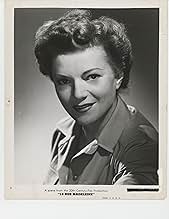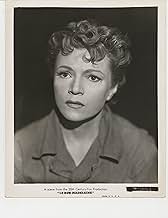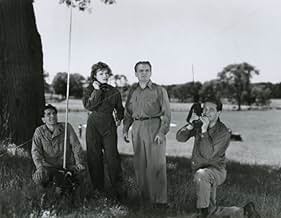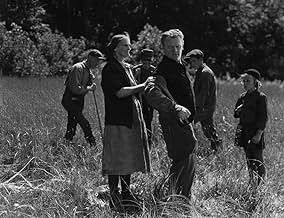Il capo delle spie Bob Sharkey scopre che uno degli agenti in addestramento è in realtà una spia nazista. La decisione di non arrestarlo subito si trasforma in una tragedia.Il capo delle spie Bob Sharkey scopre che uno degli agenti in addestramento è in realtà una spia nazista. La decisione di non arrestarlo subito si trasforma in una tragedia.Il capo delle spie Bob Sharkey scopre che uno degli agenti in addestramento è in realtà una spia nazista. La decisione di non arrestarlo subito si trasforma in una tragedia.
- Psychiatrist
- (scene tagliate)
- Burglary Instructor
- (scene tagliate)
- Resistance Fighter
- (non citato nei titoli originali)
- Instructor
- (non citato nei titoli originali)
- Joseph
- (non citato nei titoli originali)
- German Officer
- (non citato nei titoli originali)
- German Officer
- (non citato nei titoli originali)
- Second Jump Master
- (non citato nei titoli originali)
- Instructor
- (non citato nei titoli originali)
- RAF Officer
- (non citato nei titoli originali)
- German Officer
- (non citato nei titoli originali)
Recensioni in evidenza
Biggest pluses--excellent writing, pacing and acting (in that order).
Bob Sharkey (James Cagney) trains young men and women to be American secret agents. These "077 candidates" go through tough physical and mental tests. Candidates who succeed are then sent on military intelligence assignments overseas. But one of those being trained by Sharkey is a German mole, working for Hitler.
In the film's first half, Sharkey finds the mole. The second half plot follows Sharkey's efforts both to deactivate the mole, and to find a man named Duclois, the builder of a German rocket depot, a facility constructed to launch bombs against England, and located in Nazi-occupied France. The mole, headquartered in an imposing building at 13 Rue Madeleine in the French port city of Le Havre, cleverly makes Sharkey's double mission difficult. And the film ends with a riveting climax that is surprisingly realistic for a 1940's film.
Cagney gives a really good performance. The film's screenplay allows for sufficient character development, unusual for WWII films. And with tight editing, the plot zips along at a fast pace, covering a lot of story material, so that viewers need to pay attention or risk missing important plot details.
Except for that awful prologue, everything about "13 Rue Madeleine" is high quality: the costumes, the dialogue, the B&W cinematography, and especially the acting and the editing. Director Henry Hathaway even uses authentic locales, further elevating the film's overall quality.
As a WWII espionage thriller, I cannot think of a better film than "13 Rue Madeleine".
Despite some nice performances, notably from Cagney and Conte, the film under Henry Hathaway's direction was quite slow; he was lumbered with a script where it was difficult to develop any feelings for most of the characters, as they were underdeveloped. There were some good scenes, particularly the ones with Jaffe's character and the French resistance. Darryl F. Zanuck brought the pretty, petite Annabella over from France to star her in films, unaware that she would fall in love with his top male star, Tyrone Power. When he tried to discourage the relationship by sending her back to France to do some films, she refused to leave her man, thus finishing her as far as Zanuck was concerned. It's a shame because although you can't tell in this movie, Annabella was an excellent actress, as she would prove on the stage. It's fun to see Karl Malden and E.G. Marshall in small parts.
The end of the film is powerful, but I prefer "OSS," also a small, semidocumentary film - catch that one if you have a chance.
This movie starts slowly and gets gradually better as it goes, until a gripping final half hour and a shocking, dramatic ending. So it's worth the ride, and worth seeing James Cagney who is at the top of his game here (he is about to make his masterpiece, White Heat, after 15 years of gangster portrayals.) Of course here his tough guy persona is put to use for the good of us all, a patriot training a group of high level war time spies. The Nazis are brutal, and World War II is unrelenting, so even this highly skilled people die. It's a reminder how tragic the war was. It is made to be exciting and even fascinating, but most of all dangerous.
Though purely fiction, for legal reasons (the pre-CIA OSS spy organization didn't want too much revealed in the movie), the filming is meant to seem realistic in a documentary way, and it begins with an authoritative voice-over and what looks like some vintage footage. This "information" is given for too long a time, and if you are not a war expert, or even know what WWII was all about, this will be too gripping. But eventually the leads all start to take on real roles, and they move from their training in the U.S. (it was filmed in Quebec City, actually), to behind enemy lines. This is then really great stuff.
Director Henry Hathaway followed this same format (even with the title) in the 1945 The House on 92nd Street and it has some of the same flaws, and the same kind of superb second half. And a year later he did a third in the same mode, Call Northside 777. It was a successful formula for a public learning about its own federal level spy and police forces, Hathaway was a really good director, and we all wish he had taken these films in the direction of Kiss of Death, which is a gem, but he didn't, probably because of producers with ideas of their own, and so we have this trio of offbeat films with only parts that are amazing. Which isn't so bad.
Lo sapevi?
- QuizJames Cagney at one time was the highest ranking Caucasian black belt in judo, and displayed a little of his expertise in the early part of this movie. He demonstrated to the agents-in-training how to properly roll heels over head on a mat. He said to slap the ground to lessen the impact. This is probably the first lesson learned in judo training. Cagney had already shown his skill in another movie, "Blood on the Sun" (1945), in which he battled the villain in hand-to-hand combat in a wharf side warehouse. In the scene he does not use a stunt double.
- BlooperWhen the resistance listen to their personal message on the news, the radio news reader from London is clearly American. Such messages were broadcast by the BBC.
- Citazioni
Charles Gibson: I don't want to send you.
Robert Emmett 'Bob' Sharkey: I've been working hard. I need the change.
Charles Gibson: You won't come back.
Robert Emmett 'Bob' Sharkey: [Gibson drops his eyes] I've just discovered something about you.
Charles Gibson: What?
Robert Emmett 'Bob' Sharkey: You're a worrier.
- Curiosità sui creditiPrologue, shown printed in a book: No single story could ever pay full tribute to the accomplishments of the U.S. Army Intelligence in World War II. Working secretly behind enemy lines, in close cooperation with our Allies, its brilliant work was an acknowledged factor in the final victory. The page turns to reveal: In order to obtain the maximum of realism and authenticity, all the exterior and interior settings in this Motion Picture were photographed in the field - - and, whenever possible, at the actual locations.
- ConnessioniEdited into All This and World War II (1976)
I più visti
- How long is 13 Rue Madeleine?Powered by Alexa
Dettagli
- Tempo di esecuzione1 ora 35 minuti
- Colore
- Proporzioni
- 1.37 : 1
Contribuisci a questa pagina


































